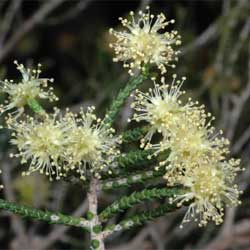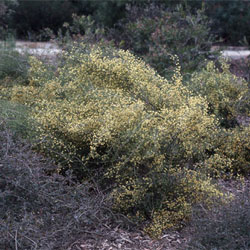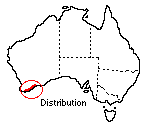Melaleuca micromera
 |
 |
Melaleuca micromera is an unusual shrub from the south-west of Western Australia where it grows on dry, sandy plains and in gravelly soils. It makes a large shrub, low and spreading, or compact and upright, when it is described as resembling a small conifer.
 Like many Melaleuca species, it is attractive in foliage and flower,
but unique among them; in fact it is a distinctive species for any kind of garden
on account of its twisting branches. Growth is dry and slender, easily snapped,
though pliant in wind in all situations in the Australian National Botanic Gardens.
The lightweight branches are greyish brown and they curve, twist and wave in
various directions. Numerous short, fine lateral stems often form feathery tufts,
slightly matted.
Like many Melaleuca species, it is attractive in foliage and flower,
but unique among them; in fact it is a distinctive species for any kind of garden
on account of its twisting branches. Growth is dry and slender, easily snapped,
though pliant in wind in all situations in the Australian National Botanic Gardens.
The lightweight branches are greyish brown and they curve, twist and wave in
various directions. Numerous short, fine lateral stems often form feathery tufts,
slightly matted.
Specimens in these gardens are in sheltered positions favouring free growth, in light shade from Eucalyptus and taller shrubs. The soil is light and mulched with bark chips and leaves, watered moderately and fed occasionally with a complete fertiliser around each plant.
Isolated plants are upright, 1.5 m high at eight years old spreading 1.5 - 2 m across. Plants confined among other shrubs are irregular, reaching along the ground to the front of the border and fitting gracefully into available space. This is an important point in a closely planted border. The shrubs are completely winter hardy in Canberra, and in drought years they survived though growing bare. Bushy growth to ground level was resumed as soon as more watering became available.
The light-coloured stems show up looking as if threaded through the minute scale-like leaves, for each leaf has one face pressed closely on the stem. On some stems continuous foliage gives the effect of a fine green cord. Under a hand lens the details of the curious leaves can be seen. They are in whorls of three, roughly shield-shaped and for their size quite thick and succulent with one or two dots - these are oil glands. When a few leaves are crushed the glands release a perfume typical of the family Myrtaceae, in which all leaves have these glands.
Most of the year the shrubs are a cool green, freshened by paler tints in spring when new tips are growing before the flowers are finished. This is the earliest spring flowering Melaleuca in the Gardens, opening even in late July some years on sheltered branches. Early October is more usual and flowers open for about five weeks, at the tips of most laterals and often massed. The flowers too are unusual, resembling Wattle balls just under 1 cm across. Actually they are 'brush' flowers as in many Melaleuca species, but rounded; the colour is a pale yellow.
Seed capsules embedded in the wood remain unopened on the plant for years, and to obtain the seed a piece of stem can be kept indoors in a bag, the capsules opening in a few days in a warm room. New plants are raised from seed or cuttings, but are not easily bought as the species is not yet widely known in cultivation.
Cut stems are attractive and last well in shallow water, gradually drying out quite usefully. One flexible stem alone makes a small arrangement, falling easily into various graceful positions when wedged among small rocks on a pinholder. This long-lived and trouble-free shrub will become popular for small spaces and is recommended also for growing in tubs or cascading among large rocks or down a slope. It can be trimmed to shape as a small hedge, with plants about 1 m apart.
Text by ANBG staff (1974)
Name meaning: Melaleuca micromeraMelaleuca - from the Greek, melas, black, and leukos, white, as the first Melaleuca discovered had white branches but a black trunk, possibly from fire. Another opinion contrasts the white bark with the very dark foliage of some species; micromera - from two Greek words meaning small and parts, an
apt reference |
![An Australian Government Initiative [logo]](/images/austgovt_brown_90px.gif)

